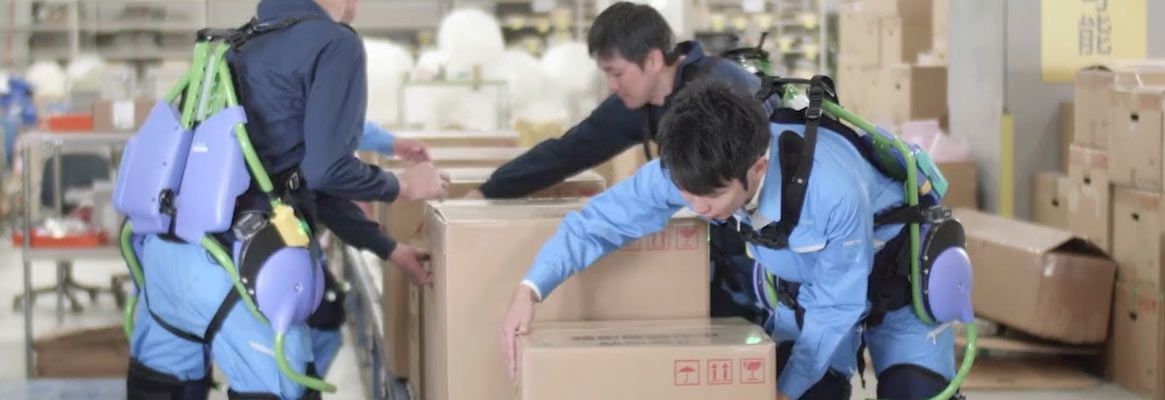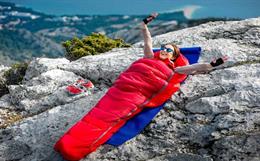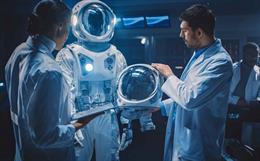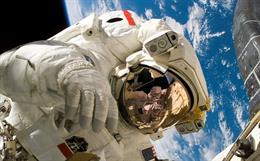Background:
Japan
Concepts:
The basicdesign concepts of the power assisting suit consist of four points, i.e.
- An enough safety system. The controllability by the care personnel is must be assured, i.e., the assisting system consists of a master (wearer's body) and slave (suit) system in one unit.
- The elimination of mechanical parts in front of the suit between the patient and the care personnel. The arms and breast of the nurse could be in direct contact with the body of the patient carried in her arms. This results in good feelings between the patient and the nurse.
- Flexible joints using pneumatic rotary actuators using pressure cuffs to give tender touch to the joints of the care personnel. With this air bag, big power is able to be generated even by low air pressure. So, it is possible to drive with small and light air pumps which are driven by portable batteries, it was possible to become the suit of a stand alone(completely independent) type.
- Assisting forces correspond with the necessary forces to the joints which are realized by a newly developed muscle hardness sensor. In addition, as a backup and fail safe system, necessary joint torque for maintaining a position is calculated from static body mechanics.
Mechanism:
Thephotograph of the stand alone type wearable power assisting suit andconstruction are shown in Fig.1. The shoulder of the arm unit can swing backand forth and side to side. The joints of the suit have double axles to extendmovable area. Each unit can bend along with the bending of the arm, the waistand the leg. The joints of the elbows, waist and knees are rotated by directdrive pneumatic rotary actuators which are driven by micro air pumps applied byportable Ni-Cd batteries. Pneumatic rotary actuators using pressure cuffs givetender touch to the wearer and the maximum output force of them is limited bythe maximum output pressure of micro air pump (0.1MPa). An embeddedmicrocomputer and pump driving circuits are mounted on the back. The weight ofthe suit is about 32 [kg]. But, when the wearer stands upright, the entireweight of the suit can be supported by the leg units, and when the wearer bendsat the waist or knee, the weights of the waist and arm units can be supportedby the actuators. However, when the nursing operation is done, the wearersomewhat feel the weight of the suit.
The exerting muscle forces of the arms, waist and legs of the care personnel are detected by the muscle hardness sensors placed on the care personnels upper arms, on the legs above the knees and on the back above the hip. The output signals of the sensors are transmitted to the embedded microcomputer. The embedded microcomputer calculates the necessary joint torques for maintaining the position of lifting a patient and the torques are combined with the output signals of the muscle sensors to make control signals inputted into the air pump driving circuits. Then the supply of air flow to the cuff changes in accordance with the necessary joint torque. The necessary joint torques and the muscle forces driving the joints are estimated by computing the equations of body mechanics, as a function of the joint angles. The joint angles are detected by potentiometers.
Fig.1 Construction of Power Assist Suit
Fig.2 Sensing and Control System of Power Assist Suit
About the Author:
The author is associated with Kanagawa Institute of Technology.
To read more articles on Textile, Industry, Technical Textile, Dyes & Chemicals, Machinery, Fashion, Apparel, Technology, Retail, Leather, Footwear & Jewellery, Software and General please visit http://articles.fibre2fashion.com
To promote your company, product and services via promotional article, follow
this link: http://www.fibre2fashion.com/services/article-writing-service/content-promotion-services.asp





_Small.jpg)


